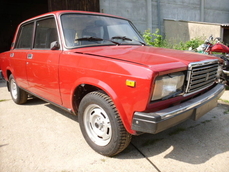Ifa Other 902/2 HP , Vorgänger Barkas B 1000 1957
General description :
Unsere Öffnungszeiten : Montag bis Samstag 8-16 Uhr oder nach Vereinbarung Besichtigung und Probefahrt bitte nur nach Absprache.
Beschreibung : Barkas Framo V 901 / 2 HP . Der Framo ist vollständig und bis auf Kleinigkeiten original. Der Motor läuft. Die Kotflügel sind in aufarbeitungsfähigem Zustand. Das Holz muß überarbeitet werden. . Der Rahmen ist i.o.
Der Lack platzt teilweise ab, ist schlecht und stark beschädigt
Die Holzpritsche muß erneuert werden. Insgesamt eine gute Basis für eine überschaubare Restaurierung .
Wir weisen darauf hin, daß es sich um gebrauchte Fahrzeuge handelt, welche nicht komplett durchrepariert wurden . Der Verkauf erfolgt daher vorrangig an Bastler
Weitere Bilder und Infos gern per Mail. Transport innerhalb Dtschl. max 250 €.Tausch / Inzahlungnahme gern auch mit Wertausgleich mgl. Mopedkennzeichen vor Ort mgl. für 68€ jährlich .
Empfehlung : Besuchen Sie auch das Calauer Oldtimermuseum , Mobile Welt des Ostens `in 03205 Calau, Straße der Freundschaft 28. Täglich geöffnet von 10 – 17 Uhr. Mittwoch geschlossen. Über 200 Exponate .
Im Internet zu finden unter:
http://www.mobileweltdesostens.de
auf Facebook ->>>
https://www.facebook.com/MobileWeltDesOstens
1957 Ifa Other 902/2 HP , Vorgänger Barkas B 1000 is listed for sale on ClassicDigest in Straße der Freundschaft 28DE-03205 Calau by Kfz-Handel Steffen Lange for €3000.
Car Facts
Car type : Car Make : Ifa Model : Other Model Version : 902/2 HP , Vorgänger Barkas B 1000 Engine size : 0.0 Model Year : 1957 Sub type : Pick up Location : Straße der Freundschaft 28DE-03205 Calau Vehicle Registration : Undefined
3000 €
Seller Information
Kfz-Handel Steffen Lange
Kfz-Handel Steffen Lange
+49 (0)172 4301472
Kfz-Handel Steffen Lange
+49 (0)172 4301472
Other cars listed for sale by this dealer
About Ifa
The IFA (Industrieverband Fahrzeugbau) was indeed a conglomerate of East German automotive manufacturers that succeeded the DKW brand after World War II. IFA was established in East Germany as a state-controlled organization in 1948, consolidating several automotive manufacturers into one entity. This conglomerate was created as part of the post-war division of Germany and was meant to help revive the East German economy and create an automotive industry in the Eastern Bloc.Some of the key companies that were merged to form IFA included:
Auto Union: Auto Union was a pre-war German conglomerate that consisted of four brands - Audi, DKW, Horch, and Wanderer. After World War II, the Soviet occupation authorities in East Germany took control of Auto Union, which included the DKW brand.
VEB (Volkseigener Betrieb) Sachsenring: This company was known for manufacturing motorcycles and later became a part of IFA, producing the iconic Trabant.
Under the IFA umbrella, various models were produced, but one of the most famous and enduring ones was the Trabant. The Trabant, often referred to as the "Trabi," was a small two-stroke engine car that became an iconic symbol of East Germany. It was produced by VEB Sachsenring, which later became part of IFA. The Trabant was produced in various models and versions, and it remained in production for several decades.
Another notable vehicle produced under the IFA brand was the Wartburg, which was manufactured by VEB Automobilwerk Eisenach. The Wartburg was a series of cars that were produced with different body styles and engine options, including two-stroke and four-stroke engines.
The IFA conglomerate also produced motorcycles, trucks, and other vehicles during its existence.
It's worth noting that IFA was dissolved in 1952, and the various vehicle manufacturers continued under different state-owned companies. For example, the Wartburg brand was continued by VEB Automobilwerk Eisenach, while the Trabant continued to be produced under VEB Sachsenring. These vehicles became some of the most recognizable and enduring symbols of East Germany during the Cold War era.




















